What is screen the screener in basketball
Screen the screener, also referred to as pick the picker, is an offensive basketball tactic that occurs when one particular player cuts to a certain area of the court to set an initial screen for a secondary player and after that, the initial screener seeks to get open via an additional screen from another player.
What are examples of half court set plays that feature screen the screener action
Below are examples of half court set plays that feature screen the screener action.
Additionally, most of the set plays in general comprise multiple options in which an offensive player could have an opportunity to score points near the basket and/or near the perimeter areas of the court.
Furthermore, it should also be mentioned that the numbers on the diagrams below represent standard basketball positions, particularly for offensive players, unless noted otherwise.
In essence, 1 is representative of the point guard position while 2 is indicative of the shooting guard position.
3 denotes the small forward position, 4 represents the power forward position, and 5 signifies the center position.
Set play #1
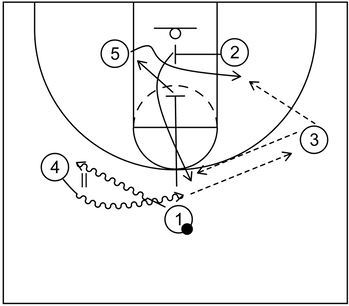
This is an example of a simple half court set play that features screen the screener action from a 3 out 2 in formation.
To start the play, 1 has possession of the basketball, represented by the black dot, and dribbles it toward 4, represented by the wavy line.
Next, 1 executes dribble handoff action so that 4 can receive possession of the ball, shown by way of the double pipe symbol.
Afterwards, 4 dribbles the ball back toward the original location at the top.
Following that, 3 receives the ball from 4 via a basic pass, represented by the dotted arrow.
As that action happens,5 cuts across the lane to the right side low post area, shown by the solid arrow, via a cross screen set by 2, indicated by the tee-like symbol.
Immediately after setting the cross screen, 2 cuts to the top via the down screen set by 4, which also completes the screen the screener action.
Furthermore, after setting the down screen, 4 could fill the vacant left side low post block.
From there, 5 could receive the ball from 3 and score via a low post move near the basket.
Alternatively, 2 could receive the ball from 3 and take a three-point jump shot if that is open.
Set play #2
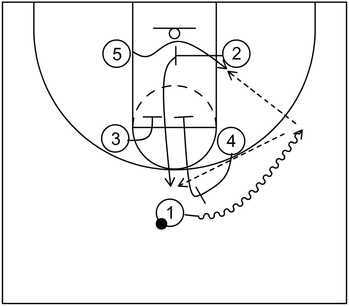
This is an example of a half court set play with screen the screener action, initiated from a box formation.
To begin, 1 dribbles toward the right side wing via the on-ball screen set by 4.
Also, as that happens, 5 cuts to the right side low post area via a cross screen set by 2.
Afterwards, 2 cuts to the vacant area near the top behind the three-point line by way of the elevator screen set by 3 and 4.
It should be noted as well that the cross screen followed by the elevator screen completes the screen the screener action.
Next, 5 could receive the ball from 1 and score near the basket, particularly by way of a low post move.
Alternatively, 2 could receive the ball from 1 and take the three-point shot if that is open.
Set play #3 – Part 1
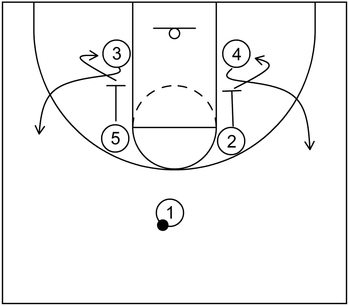
This is an example of another basketball play initiated from a box formation that includes a pair of scoring options near the basket or near the perimeter.
To begin, 3 and 4 cut to the left side and right side wing areas via the down screens set by 5 and 2 respectively. Also, 5 and 2 fill the vacant low post areas previously occupied by 3 and 4.
Set play #3 – Part 2
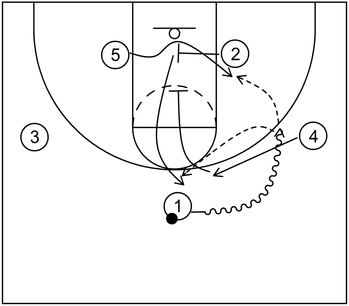
Next, 5 cuts to the right side wing via a cross screen set by 2. As that occurs, 4 cuts toward 1 as if to set an on-ball screen and at the same time, 1 dribbles toward 4 as if to receive an on-ball screen from 4.
However, 4 performs a ghost screen by cutting away from 1 just before setting the screen. From there, 1 continues to dribble towards the right side wing while 2 cuts to the top via the down screen set by 4, which finishes the action of screen the screener.
After that, 5 could receive the ball from 1 and score via a low post move. Moreover, as an alternative option, 2 could receive the ball from 1 and take the three-point jump shot if open.
Set play #4
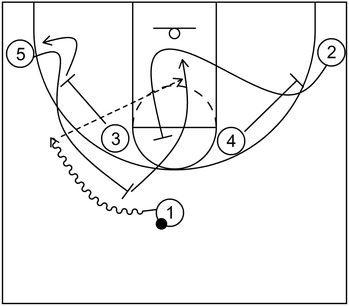
This is an example of a basketball set play initiated from the Horns offense that creates a scoring option near the rim.
To start, 5 cuts to the left slot area via the ram screen set by 3 and afterwards, 1 dribbles toward the left side wing via the on-ball screen set by 5.
Furthermore, after setting the ram screen, 3 could fill the left side corner previously occupied by 5. Also, as that occurs, 2 executes a curl cut towards the basket via the wide pin down screen set by 4.
However, that is mainly false action to occupy the defender who was initially on the weak side of the court.
Following that, 5 rolls to the basket via the back screen set by 2, to complete the screen the screener action, which also incidentally happens to be Spain pick and roll as well.
After that, 5 could receive the ball from 1 and score near the rim via a layup or dunk.
Set play #5 – Part 1

This is an example of another basketball play initiated from the Horns formation that produces various scoring options. To start, 1 dribbles toward the right slot area and as that happens, 3 cuts to the left slot area via the wide pin down screen set by 5.
Additionally, 5 fills the left side corner after setting the screen. Next, 3 receives the ball from 1 and afterwards, 2 rejects a wide pin down screen set by 4 and swiftly performs a backdoor cut towards the basket.
Following that, 2 could receive the ball from 3 and score near the rim.
Nevertheless, If 2 is not open, then 2 could continue the cut through to the left side low post block while 4 fills the right side corner.
Set play #5 – Part 2
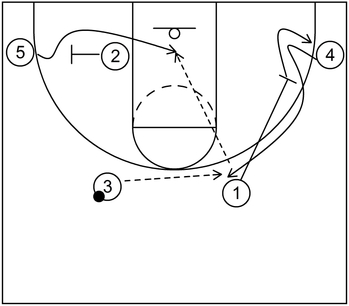
Next, while 3 still has possession of the ball, 4 could cut to the right slot area via the pin down screen set by 1, who also fills the right side corner.
Afterwards, 4 could receive the ball from 3 and take the three-point jump shot if that is open.
If 4 receives the ball but the open shot is not available, then 5 could cut to the basket via the flex screen set by 2, which also completes screen the screener action since 5 set a screen earlier.
From there, 5 could receive the ball from 4 and score via a layup or dunk.
Set play #6
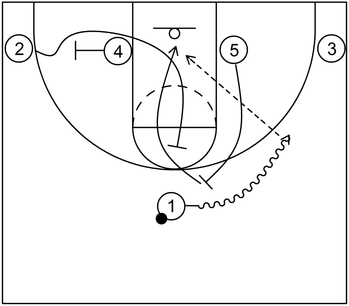
This is an example of a basketball set play initiated from the 1-4 low formation that seeks to produce a high percentage scoring opportunity by way of quick hitting action.
To begin, 1 dribbles toward the right side wing via the on-ball screen set by 5. At the same time, 2 cuts to the basket via the flex screen set by 4. However, that is false action.
In reality, 2 executes Spain pick and roll by setting a back screen for 5 who rolls to the basket. Moreover, when 5 rolls to the basket via the back screen, this also completes the screen the screener action as well.
From that point, 5 could receive the ball from 1 and score via a high percentage layup or dunk near the rim.
Affiliate Disclosure: I may earn a commission on qualifying purchases made through the links below.
What is an example of an inbound play that features screen the screener action
Sideline out of bounds play #1 – Part 1
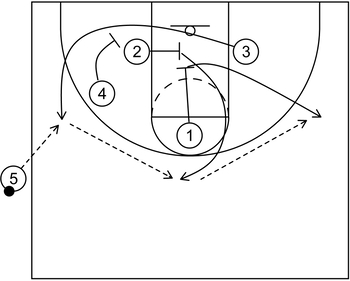
This is an example of a sideline out of bounds play that includes scoring opportunities near the perimeter as well as near the basket.
It is derived from Over 50 Sensational Sideline Plays by Winning Hoops.
To begin, 3 cuts to the left side wing area via the screens set by 2 and 4.
Afterwards, 3 can receive the ball from 5.
At the same time as 3 is gaining possession of the ball, 2 cuts to the top area via the down screen set by 1, which also completes the screen the screener action.
Furthermore, 1 also pops out to the right side wing area after setting the down screen.
Next, 2 could receive the ball from 3 and take the three-point jump shot if that is open.
If 2 is not open for the jump shot, then 1 could receive the ball from 2.
Sideline out of bounds play #1 – Part 2

After 1 gains possession of the ball, 5 could cut to the basket by way of screens set by 3 and 4.
From there, 5 could receive the ball from 1 and score at the rim via a layup or dunk.